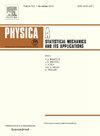Energy landscapes of spin models on the Snub Archimedean ( 32, 4, 3, 4) lattice
IF 2.8
3区 物理与天体物理
Q2 PHYSICS, MULTIDISCIPLINARY
Physica A: Statistical Mechanics and its Applications
Pub Date : 2025-02-01
DOI:10.1016/j.physa.2024.130311
引用次数: 0
Abstract
We study the energy landscapes of three spin models, comprised of 36 spins, confined to a Snub Archimedean lattice of type (, 4,3,4). Our models differ in the possible range of spin–spin interaction, namely , , and . Characteristic of discrete interactions these spin systems can exhibit extended minimum energy structures which are categorized into four types, namely regular minima, type-1 dales, type-2 dales, and type-3 dales. The different types are distinguished in the disconnectivity graphs via colors and their sizes are indicated for the different energy levels via a bar chart. Each of the models shows distinct features in the structure of the energy landscapes. The model only exhibits regular minima, whereas all types are found in the and models. Their landscapes resemble a palm leaf structure with increasing occurrence of multiple funnels for increasing range of bonds. Further evaluation of these structures reveals that the majority of the minima occupy the medium energy range and that all the structures exhibit high barriers at low energies and low barriers at medium to high energies indicative that low energy traps are more difficult to escape than high energy traps. The length of the transition paths from the minima structures to the transition states allows an investigation into the applicability of Hammond’s postulate to spin systems. The results suggest that for the model statistically the configurations of the transition states are closer related to the minima that require less increase in energy than to the minima that require a larger increase in energy. However, due to the presence of flat energy structures, and a larger bond range in the and models this occurs only up to medium energies.
求助全文
约1分钟内获得全文
求助全文
来源期刊
CiteScore
7.20
自引率
9.10%
发文量
852
审稿时长
6.6 months
期刊介绍:
Physica A: Statistical Mechanics and its Applications
Recognized by the European Physical Society
Physica A publishes research in the field of statistical mechanics and its applications.
Statistical mechanics sets out to explain the behaviour of macroscopic systems by studying the statistical properties of their microscopic constituents.
Applications of the techniques of statistical mechanics are widespread, and include: applications to physical systems such as solids, liquids and gases; applications to chemical and biological systems (colloids, interfaces, complex fluids, polymers and biopolymers, cell physics); and other interdisciplinary applications to for instance biological, economical and sociological systems.

 求助内容:
求助内容: 应助结果提醒方式:
应助结果提醒方式:


